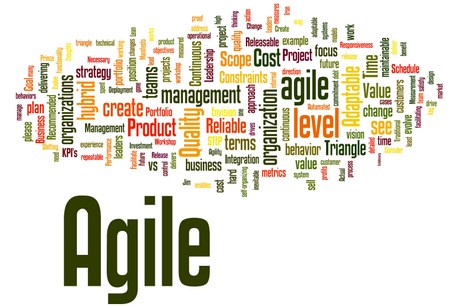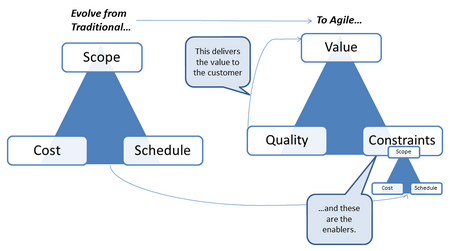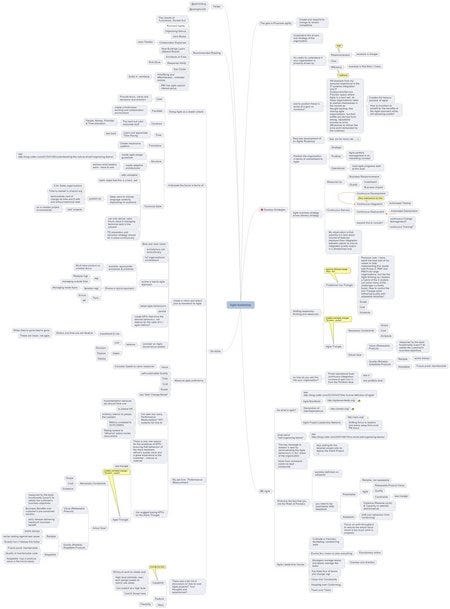How to Lead with Agile-ity. Lessons from #agileAus 2010 Agile Leadership workshop in Melbourne
I spent a few valuable hours on Wednesday morning, 14 September at the 2010 Agile Executives & Leaders Workshop with Jim Highsmith, co-author of the Agile Manifesto and Director of Cutter Consortiums Agile Product & Project Management practice , and others discussing
- revising performance measurements
- facilitating self-organizing teams
- developing strategies for the operational portfolio
- and strategic agility.
Below are some of my thoughts and takeaways, Jim’s book recommendations and links for further reading. I’ve included a mindmap as a structure to further develop for your own Agile journey. I used iThoughtsHD for the iPad to capture this. Enjoy and please comment below… Here’s a snapshot if you’re not inclined to read all the detail…

My Key Take aways The Leadership goal is Proactive Agility — Create and respond to change to remain competitive STEP 1 — Develop Strategies. Some high level steps to get you started…
- Understand the drivers and strategy of the organization
- It’s useful to understand if your organization is primarily driven by
- Responsiveness = Agileexample: Googleover
- Efficiency = Traditionalexample: Wal-Mart
- and to position these in terms of a Goal vs Constraint
- An example from my personal experience is the IT Systems Integration and IT Outsourcers/Service Provider space where Agile is a hard internal sell, as these organizations need to position themselves in the market as thought-leading, fast moving agile organizations, but their profits are derived from strong, repeatable process to drive efficiencies to deliver the price point demanded by the customer.
- This creates the famous paradox of agile!
- How to transition to benefit from the Agile approach while still delivering profits?
- Requires development of an Agility Roadmap
- Position the organization in terms of the commitment level to Agile
- Strategic
- Organizational Leadership understands and actively drives Agile
- Portfolio
- Agile portfolio management level
- Operational
- most Agile programs start at this level
- Agile business strategy drives delivery strategy
- Measured by
- Business Responsiveness
- Quality
- Investment
- Business Impact
- Continuous Delivery applied at all 3 levels, being
- Continuous Development
- Continuous Integration = Many organizations are here
- Automated Testing
- Continuous Deployment
- Automated Deployment
- We could expand this to include
- continuous Change Management?
- continuous Training?
- My observation is that possibly it is less about volume of features deployed than integration between stacks to ensure integrated quality output in a streamlined way
- Shifting leadership thinking and measures

- Traditional Iron Triangle = assumes Minimal change . “Plan — Do” Personal note: I have spent the best part of my career to date implementing this model, with Prince 2, PMP and PMO’s for large organizations, but I like the Agile thinking as I believe a hybrid of the 2 models can solve many of the challenges currently faced. The challenge is how to control the Iron Triangle while delivering quality with adaptable reliability?
- Scope
- Cost
- Schedule
- Agile Triangle = enables inevitable changes “Envision — evolve” . Includes
- Necessary Constraints
- Scope
- Cost
- Schedule
- Actual Goal
- Value (Releasable Product)
- measured by the least functionality (see Lean Startups ) to satisfy the customers business objectives
- Quality (Reliable, Adaptable Product)
- Reliable = works consistently
- Adaptable = Future proof, maintainable
- so how do you sell this into your organization?
- Prove operational level Continuous Integration success to gain buy in from the Portfolio level
- see ci
- see portfolio level
- STEP 2 — BE Agile
- So what is agile?
- Agile Manifesto
- Declaration of InterDependence
- Agile Project Leadership Network
- Shifting focus to leaders and execs away from pure PM focus
- So what about “self-organizing teams”
- The key message to leaders is lead by demonstrating the Agile behaviors in ALL areas of the organization
- stop asking for the detailed project plan to deploy the Agile Project ;-)
- move from command-control to lead-collaborate
- Embrace the fact that you are the Rider of Paradox
- You DO need to be predictable AND adaptable
- Predictable
- Reliable, not repeatable
- Agile
- Releasable Product Value
- Quality
- Constraints
- see Agile triangle
- Cadence (Release cycle) & Capacity vs detailed task/schedule
- Adaptable
- shift your behavior from ‘conforming’
- Focus on work throughput to reduce the actual issue which is too much work in progress
- Agile Leadership Values
- Cultivate a Visionary, facilitating, constraining style
- Evolve thru vision vs plan everything
- Evolutionary action
- Managers manage teams and teams manage the tasks
- Oversee and provide direction
- Facilitate flow of teams and change management
- Value over Constraints
- Adapting over Conforming
- Team over Tasks
- STEP 3 — Do Agile
- Doing Agile as a leader entails
- Lead
- Provide focus, clarity and decisions and direction
- Facilitate
- create a frictionless working and collaboration environment
- Constrain
- The hard but valid corporate stuff
- People, Money, Priorities & Time allocation
- Anticipate the future in terms of
- Time
- Learn and appreciate Time Pacing
- Transitions
- Create responsive systems
- Structure
- create agile design guidelines
- see http://blog.cutter.com/2010/01/26/understanding-the-nature-of-self-organizing-teams/
- create adaptive architectures
- delivers what leaders want — more & now
- Technical Debt
- The workshop noted that getting resources and funding to address this is a really hard sell
- ideas were to choose language carefully, depending on audience
- position in terms of
- $ for Sales organizations
- Time to market in product organization
- demonstrate cost of change in terms of time and $ with and without technical debt
- ‘pad’ projects
- ok in smaller project environments
- can only deliver rapid future value if managing technical debt in the present
- TD prevention and reduction strategy should be in place continuously
- create a vision and action plan to transform to Agile
- Bold and clear vision
- evolutionary not revolutionary
- full organizational commitment
- evolve a hybrid agile approach
- scalable, appropriate processes & practices
- Must have product vs process focus
- Evolve a hybrid approach
- Portfolio management
- Project Management
- Release management
- Manage outside time
- Iteration management
- Managing inside team
- Tech
- Scrum
- Xp
- adopt agile behaviors
- persist
- create KPI’s that drive the desired behavior, not metrics for the sake of it = agile metrics?
- consider an Agile Governance system
- balance
- Investment & risk
- Dollars and time are not iterative
- When they’re gone they’re gone
- These are linear, not agile. Consider this when communicating
- over
- Gates
- Envision
- Explore
- Deploy
- Measure agile proficiency
- Value
- Consider Speed to value measures
- self-sustainable Quality
- Time
- Cost
- Scope
- see ‘Satir Change Model’
- THE key driver of behavior and a favorite enabler of mine: Performance Measurement
- I’ve seen too many Performance Measurement / KPI systems fail due to
- Implementation because we should have one
- to please HR
- arbitrary metrics to please the Leaders
- Metrics unrelated to OUTCOMES
- Rating system to ‘influence’ salary review discussions
- There is only one reason for the existence of KPI’s — encouraging behavior of the team members to deliver quality value and a great experience to the customer — internal or external
- Jim suggest basing KPI’s on the Agile Triangle
- Agile Triangle = enables inevitable changes to “Envision — evolve”
- Necessary Constraints
- Scope
- Cost
- Schedule
- Actual Goal
- Value (Releasable Product)
- measured by the least functionality to satisfy the customers business objectives
- Business Benefits over customers pre-conceived solution
- early release delivering maximum business benefit
- Quality (Reliable, Adaptable Product)
- Reliable
- works always
- earlier testing against test cases
- Quality=can I release this today
- Adaptable
- Future proof, maintainable
- Quality of maintainable code
- Adaptable =can it produce value in the future easily
- NOTES: There was a fair bit of discussion on how to cost Agile projects? Please share your thoughts and experiences in the comments below…
- Jim suggested that costing can be done at the Capability level
- Minimum work to create cost
- High level estimate, plan, tech design based on hybrid use cases
- Cost & Scope here
- Recommended Reading from this workshop Recommended Links The two major traditional project management methodologies have established working groups to address the impact of Agile and hybrid models.
- PMI is has created an agile special interest group here
- Prince 2 has published a white paper on hybrid projects. On the way to Agile?
- Recommended Twitter handles to follow:
[ff aplndotorg jimhighsmith ericries]
Mindmap from the Workshop

- In conclusion, the workshop was excellent value and thought-provoking. I’ve attempted to capture the essence and look forward to your views and comments below…
